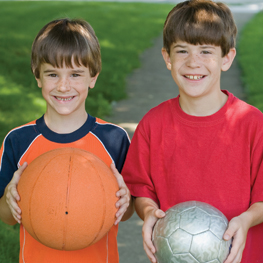
If you want to help your family live a healthier and more active life, you’re in luck. You live in a city where nearly 500 sport organizations offer over 85 different sport activities. No matter what the sport, chances are there is a sport organization in Calgary that offers opportunities to learn and play. Participating in a wide variety of sport activities (as opposed to specializing in one sport or another) is particularly important for pre-adolescent boys and girls.
In fact, the tapering process wherein a child begins to narrow their focus should only begin to happen between ages 12 and 16. (The only exception to this rule is for children who are focusing on diving, gymnastics or figure skating, where the age to begin specializing is a little younger.)
Experts agree that specializing early not only fails to provide any advantages to a child in that particular sport, it can be detrimental to both their skill level and enjoyment. Conversely, children coming from a multi-sport background have a statistically significant advantage over other children when it comes time to begin narrowing focus to just a few sport activities. They also have a reduced likelihood of injury or burnout.
Sport organizations should be adhering to what Canadian Sport for Life model calls the Long-Term Athlete Development Model, or LTAD. Future success in a given sport is predicated on the prior development of fundamental movement skills, which are best learned and mastered through participation in a wide variety of sport activities. Just as one would read a variety of books to improve their literacy, becoming physically literate involves participating in many different sport activities.
The Long-Term Athlete Development Model charts a path through seven distinct stages, the first three of which should occur consecutively prior to puberty. The Active Start stage is intended for infants to six year olds. This stage is all about unstructured play and movement, so that fundamental movement skills like running, jumping and throwing may be developed.
The second stage, called FUNdamentals, is for girls ages six through eight, and boys ages six through nine. The basic fundamental movement skills acquired in the first stage now lead into more challenging skills, like agility, balance, coordination and speed. A variety of well-structured activities, with a focus on fun rather than competition, is the best way to develop these skills.
The third stage, Learn to Train, comprises of girls ages eight to 11, and boys ages nine to 12. This is the stage wherein the fundamental movement skills mastered in the first two stages provide a solid foundation for the acquisition of fundamental sport skills. The focus is still on general sport skills in this stage, and specializing in only one or two sport activities should be avoided.
You may wish to ask the leaders of any sport program in which you’re thinking of enrolling your child about their approach to physical literacy. How do they ensure that participants acquire the necessary fundamental movement skills associated with their current stage in the Long-Term Athlete Development model? Do they adhere to Canadian Sport for Life principles? What are their views on competition? Is there an unreasonable time commitment? These are factors that might lead to a single-sport focus. The more you learn about the sport program, the better prepared you will be to support that program.
So if you have kids, get them out and active; moving, running, jumping and playing a variety of different sport activities, both structured and unstructured. And while you’re at it, pick out one or two for yourself!
For more information about Sport Calgary, contact 403-387-7772, email This email address is being protected from spambots. You need JavaScript enabled to view it., visit www.sportcalgary.ca or follow them on Twitter, @SportCalgary.
Calgary’s Child Magazine © 2024 Calgary’s Child